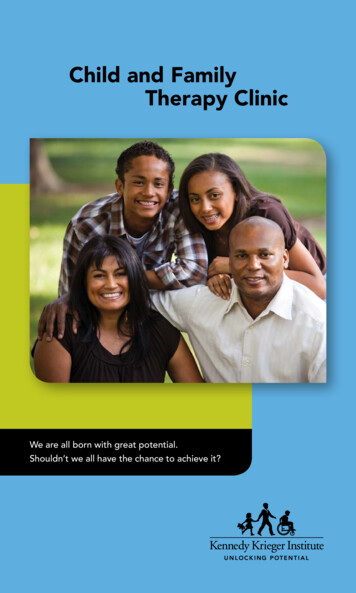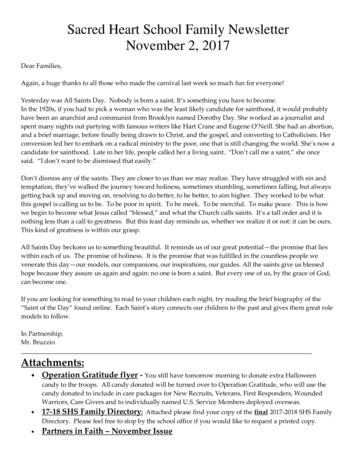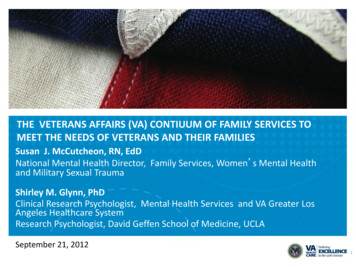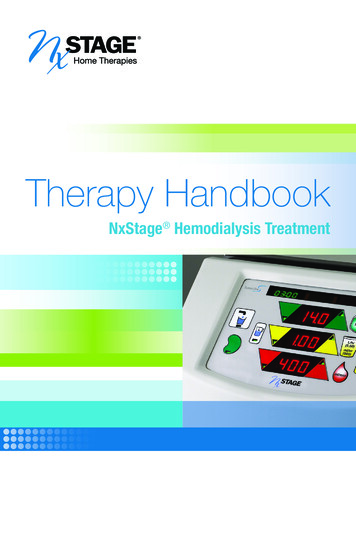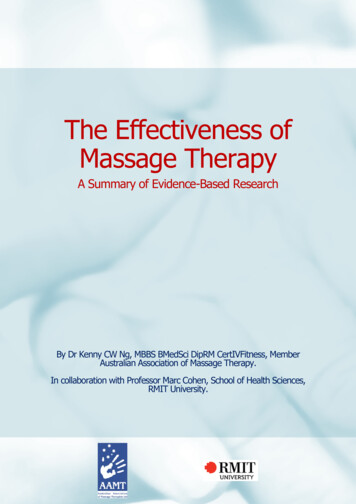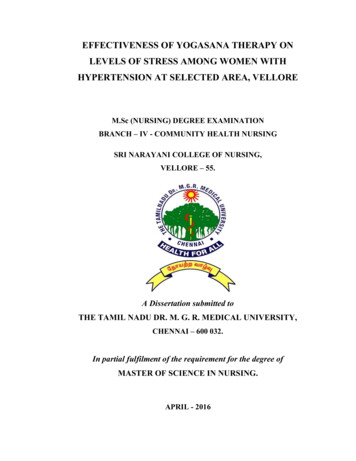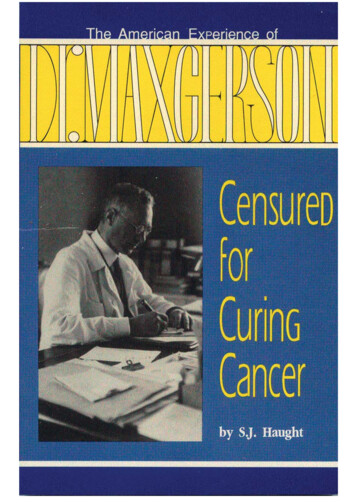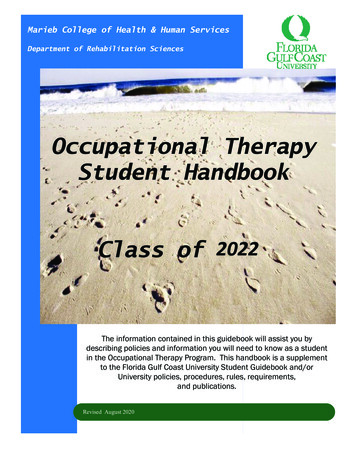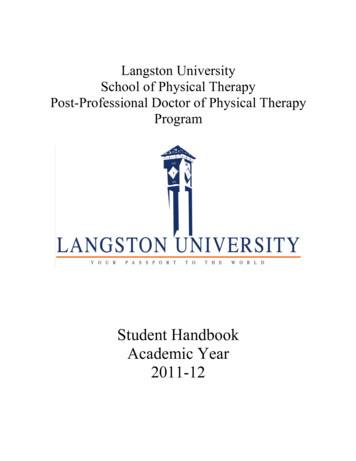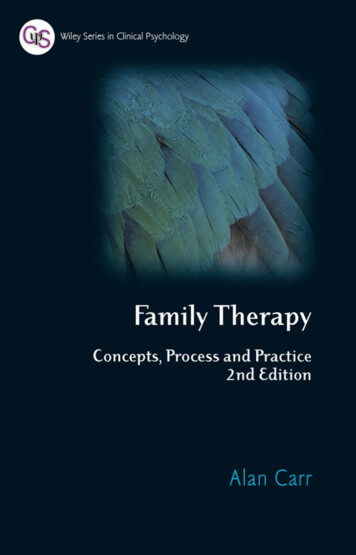
Transcription
FAMILY THERAPY
Wiley Series inCLINICAL PSYCHOLOGYAdrian Wells(Series Advisor)Alan CarrMartin HerbertGraham C.L. Davey andAdrian Wells (Editors)School of Psychological Sciences,University of Manchester, UKFamily Therapy: Concepts, Process andPractice, Second EditionClinical Child Psychology: From Theoryto Practice, Third EditionWorry And Its Psychological Disorders:Theory, Assessment And TreatmentTitles published under the series editorship of:J. Mark G. Williams(Series Editor)School of Psychology, Universityof Wales, Bangor, UKRichard G. Moore andAnne GarlandCognitive Therapy for Chronic andPersistent DepressionRoss G. Menzies andPadmal de Silva (Editors)David Kingdon andDouglas Turkington (Editors)Obsessive-Compulsive Disorder:Theory, Research and TreatmentThe Case Study Guide to CognitiveBehaviour Therapy of PsychosisHermine L. Graham,Alex Copello,Max J. Birchwood andKim T. Mueser (Editors)Substance Misuse in Psychosis: Approachesto Treatment and Service DeliveryJenny A. Petrak andBarbara Hedge (Editors)The Trauma of Sexual Assault: Treatment,Prevention and PracticeGordon J.G. Asmundson,Steven Taylor andBrian J. Cox (Editors)Kees van Heeringen (Editor)Craig A. WhiteSteven TaylorAlan CarrHealth Anxiety: Clinical and ResearchPerspectives on Hypochondriasis andRelated ConditionsUnderstanding Suicidal Behaviour:The Suicidal Process Approach to Research,Treatment and PreventionCognitive Behaviour Therapy for ChronicMedical Problems: A Guide to Assessment andTreatment in PracticeUnderstanding and Treating Panic Disorder:Cognitive-Behavioural ApproachesFamily Therapy: Concepts, Process and PracticeA list of earlier titles in the series follows the index.
FAMILY THERAPYConcepts, Process and PracticeSecond EditionAlan CarrUniversity College Dublin and Clanwilliam Institute Dublin,IrelandChichester · New York · Weinheim · Brisbane · Singapore · Toronto
Copyright 2006 John Wiley & Sons Ltd, The Atrium, Southern Gate, Chichester,West Sussex PO19 8SQ, EnglandTelephone ( 44) 1243 779777Email (for orders and customer service enquiries):cs-books@wiley.co.ukVisit our Home Page on www.wiley.comWhile every effort has been made to contact the owner of copyright of ‘At Swim-two-birds’by Flann O’Brien, we have been unable to obtain his formal copyright permission for theuse of material.All Rights Reserved. No part of this publication may be reproduced, stored in a retrievalsystem or transmitted in any form or by any means, electronic, mechanical, photocopying,recording, scanning or otherwise, except under the terms of the Copyright, Designs andPatents Act 1988 or under the terms of a licence issued by the Copyright Licensing AgencyLtd, 90 Tottenham Court Road, London W1T 4LP, UK, without the permission in writing ofthe Publisher. Requests to the Publisher should be addressed to the Permissions Department, John Wiley & Sons Ltd, The Atrium, Southern Gate, Chichester, West Sussex PO198SQ, England, or emailed to permreq@wiley.co.uk, or faxed to ( 44) 1243 770620.Designations used by companies to distinguish their products are often claimed as trademarks. All brand names and product names used in this book are trade names, servicemarks, trademarks or registered trademarks of their respective owners. The Publisher is notassociated with any product or vendor mentioned in this book.This publication is designed to provide accurate and authoritative information in regard tothe subject matter covered. It is sold on the understanding that the Publisher is not engagedin rendering professional services. If professional advice or other expert assistance is required, the services of a competent professional should be sought.Other Wiley Editorial OfficesJohn Wiley & Sons Inc., 111 River Street, Hoboken, NJ 07030, USAJossey-Bass, 989 Market Street, San Francisco, CA 94103-1741, USAWiley-VCH Verlag GmbH, Boschstr. 12, D-69469 Weinheim, GermanyJohn Wiley & Sons Australia Ltd, 42 McDougall Street, Milton, Queensland 4064, AustraliaJohn Wiley & Sons (Asia) Pte Ltd, 2 Clementi Loop #02-01, Jin Xing Distripark, Singapore 129809John Wiley & Sons Canada Ltd, 22 Worcester Road, Etobicoke, Ontario, Canada M9W 1L1Wiley also publishes its books in a variety of electronic formats. Some content that appearsin print may not be available in electronic books.Library of Congress Cataloging-in-Publication DataCarr, Alan, Dr.Family therapy: concepts, process and practice / Alan Carr.— 2nd ed.p. cm. — (The Wiley series in clinical psychology)Includes bibliographical references and index.ISBN-13: 978-0-470-01454-7 (cloth : alk. paper)ISBN-10: 0-470-01454-7 (cloth : alk. paper)ISBN-13: 978-0-470-01455-4 (pbk. : alk. paper)ISBN-10: 0-470-01455-5 (pbk. : alk. paper)1. Family psychotherapy. I. Title. II. Series.RC488.5.C367 2006616.89’156—dc222005035562British Library Cataloguing in Publication DataA catalogue record for this book is available from the British LibraryISBN-13 978-0-470-01454-7(hbk) 978-0-470-01455-4 (pbk)ISBN-10 0-470-01454-7 (hbk) 0-470-01455-5 (pbk)Typeset in 10/12 pt Palatino by Thomson Press (India) Limited, New DelhiPrinted and bound in Great Britain by TJ International, Padstow, CornwallThis book is printed on acid-free paper responsibly manufactured from sustainable forestryin which at least two trees are planted for each one used for paper production.
CONTENTSAbout the Author . . . . . . . . . . . . . . . . . . . . . . . . . . . .Foreword Alan S. Gurman . . . . . . . . . . . . . . .Preface . . . . . . . . . . . . . . . . . . . . . . . . . . . .Acknowledgements . . . . . . . . . . . . . . . . . . . . . . . . . . . .Endorsements of the first edition . . . . . . . . . . . . . . . . . . . . . . . . . . . .xixiiixvxxixxiiiPART I CENTRAL CONCEPTS INFAMILY THERAPYChapter 1Chapter 2Goals of Family TherapyAcross the Lifecycle. . . . . . . . . . . . .The family lifecycle . . . . . . . . . . . . . . .Lifecycle stages associatedwith separation and divorce . . . . .The individual lifecycle . . . . . . . . . . .Sex-role development . . . . . . . . . . . . .Gay and lesbian lifecycles . . . . . . . . .Class, creed and colour . . . . . . . . . . . .Summary . . . . . . . . . . . . . . . . . . . . . . .Further reading . . . . . . . . . . . . . . . . . .Origins of Family Therapy . . . . . . . . .Movements: Child guidance, marriagecounselling and sex therapy . . . . .Disciplines: Social work, psychiatryand clinical psychology . . . . . . . . .Group therapy: Group analysis,encounter groups, psychodramaand Gestalt therapy . . . . . . . . . . . . .Research traditions: Work groups,role theory and schizophrenia . . . .Gregory Bateson . . . . . . . . . . . . . . . . .Three organising themes: Behaviourpatterns, beliefs and contexts . . . .Summary . . . . . . . . . . . . . . . . . . . . . . .Glossary . . . . . . . . . . . . . . . . . . . . . . . .Further reading . . . . . . . . . . . . . . . . . .352935414345454748495052535668707173
viCONTENTSChapter 3Chapter 4Theories that Focus on BehaviourPatterns . . . . . . . . . . . . . . . . . . . . . . .MRI brief therapy . . . . . . . . . . . . . . . .Strategic family therapy . . . . . . . . . . .Structural family therapy . . . . . . . . . .Cognitive-behavioural marital andfamily therapy . . . . . . . . . . . . . . . . .Functional family therapy . . . . . . . . .Closing comments . . . . . . . . . . . . . . . .Glossary . . . . . . . . . . . . . . . . . . . . . . . .Further reading . . . . . . . . . . . . . . . . . .76768590939699100106Theories that Focus on BeliefSystems . . . . . . . . . . . . . . . . . . . . . . .Epistemology: Positivism,constructivism, socialconstructionism, modernism andpostmodernism . . . . . . . . . . . . . . . .A constructivist approach tofamily therapy . . . . . . . . . . . . . . . . .Milan systemic family therapy . . . . .Social constructionistdevelopments . . . . . . . . . . . . . . . . . .Solution-focused therapy . . . . . . . . . .Narrative therapy . . . . . . . . . . . . . . . .Closing comments . . . . . . . . . . . . . . . .Glossary . . . . . . . . . . . . . . . . . . . . . . . .Further reading . . . . . . . . . . . . . . . . . .128132135138140148Chapter 5Theories that Focus on Contexts . . . .Transgenerational family therapy . . .Psychoanalytic family therapy . . . . .Attachment-based therapies . . . . . . .Experiential family therapy . . . . . . . .Multisystemic family therapy . . . . . .Psychoeducational family therapy . .Closing comments . . . . . . . . . . . . . . . .Glossary . . . . . . . . . . . . . . . . . . . . . . . .Further reading . . . . . . . . . . . . . . . . . .154154164167173180182183185193Chapter 6Integrative Models . . . . . . . . . . . . . . .Metaframeworks . . . . . . . . . . . . . . . . .Integrative problem-centredtherapy . . . . . . . . . . . . . . . . . . . . . . .Brief integrative marital therapy. . . .Pluralistic couples therapy. . . . . . . . .199199110110119124202205207
CONTENTSIntegrative applications withinspecific professions . . . . . . . . . . . . .Closing comments . . . . . . . . . . . . . . . .Glossary . . . . . . . . . . . . . . . . . . . . . . . .Further reading . . . . . . . . . . . . . . . . . .vii209210211211PART II PROCESSES IN FAMILYTHERAPYChapter 7Chapter 8Chapter 9The Stages of Family Therapy . . . . . .Stage 1 – Planning . . . . . . . . . . . . . . . .Stage 2 – Assessment . . . . . . . . . . . . .Stage 3 – Treatment . . . . . . . . . . . . . . .Stage 4 – Disengaging orrecontracting . . . . . . . . . . . . . . . . . .Summary . . . . . . . . . . . . . . . . . . . . . . .Further reading . . . . . . . . . . . . . . . . . .Formulating Problems andExceptions . . . . . . . . . . . . . . . . . . . .The three-column problemformulation model . . . . . . . . . . . . .The three-column exceptionformulation model . . . . . . . . . . . . .Questions to ask when constructingthree-column formulations . . . . . .Recursive reformulation . . . . . . . . . . .Summary . . . . . . . . . . . . . . . . . . . . . . .Further reading . . . . . . . . . . . . . . . . . .Interventions for Behaviour, Beliefsand Contexts . . . . . . . . . . . . . . . . . . . .Criteria for selecting interventions . .Behaviour-focused interventions . . .Interventions focusing on beliefsystems . . . . . . . . . . . . . . . . . . . . . . .Interventions that focus on historical,contextual and constitutionalfactors . . . . . . . . . . . . . . . . . . . . . . . .Summary . . . . . . . . . . . . . . . . . . . . . . .Further reading . . . . . . . . . . . . . . . . . 76291299312313PART III FAMILY THERAPY PRACTICE WITHCHILD- AND ADOLESCENT-FOCUSEDPROBLEMSChapter 10Physical Child Abuse . . . . . . . . . . . . .Systemic model of physical childabuse . . . . . . . . . . . . . . . . . . . . . . . . .317317
viiiCONTENTSFamily therapy for physical childabuse . . . . . . . . . . . . . . . . . . . . . . . . .Summary . . . . . . . . . . . . . . . . . . . . . . .Further reading . . . . . . . . . . . . . . . . . .Chapter 11Chapter 12Chapter 13326337338Sexual Abuse . . . . . . . . . . . . . . . . . . . .Systemic model of child sexualabuse . . . . . . . . . . . . . . . . . . . . . . . . .Family therapy for child sexualabuse . . . . . . . . . . . . . . . . . . . . . . . . .Summary . . . . . . . . . . . . . . . . . . . . . . .Further reading . . . . . . . . . . . . . . . . . .339Conduct Problems . . . . . . . . . . . . . . . .Systemic model of conduct problemsFamily therapy for conductproblems . . . . . . . . . . . . . . . . . . . . . .Summary . . . . . . . . . . . . . . . . . . . . . . .Further reading . . . . . . . . . . . . . . . . . .Further reading for parents . . . . . . . .361363Drug Abuse in Adolescence . . . . . . . .Systemic model of drug abuse inadolescence. . . . . . . . . . . . . . . . . . . .Family therapy for drug abuse inadolescence. . . . . . . . . . . . . . . . . . . .Summary . . . . . . . . . . . . . . . . . . . . . . .Further reading . . . . . . . . . . . . . . . . . .339347360360371383384384386386394401402PART IV FAMILY THERAPY PRACTICE WITHADULT-FOCUSED PROBLEMSChapter 14Chapter 15Distressed Couples . . . . . . . . . . . . . . .Systemic model of distressing intimaterelationships . . . . . . . . . . . . . . . . . . .Couples therapy . . . . . . . . . . . . . . . . .Summary . . . . . . . . . . . . . . . . . . . . . . .Further reading . . . . . . . . . . . . . . . . . .Further reading for clients . . . . . . . . .Depression and Anxiety . . . . . . . . . . .Depression . . . . . . . . . . . . . . . . . . . . . .Anxiety . . . . . . . . . . . . . . . . . . . . . . . . .Systemic model of anxiety anddepression . . . . . . . . . . . . . . . . . . . .Couples therapy for anxiety anddepression . . . . . . . . . . . . . . . . . . . .Summary . . . . . . . . . . . . . . . . . . . . . . .Further reading . . . . . . . . . . . . . . . . . .405409413429429430431431432435440454455
CONTENTSChapter 16Chapter 17Alcohol Problems in Adulthood . . . .Systemic model of alcohol problemsin adulthood . . . . . . . . . . . . . . . . . . .Couples therapy for alcohol problemsin adulthood . . . . . . . . . . . . . . . . . . .Summary . . . . . . . . . . . . . . . . . . . . . . .Further reading . . . . . . . . . . . . . . . . . .Schizophrenia. . . . . . . . . . . . . . . . . . . .Systemic model of schizophrenia . . .Couples and family therapy forschizophrenia . . . . . . . . . . . . . . . . . .Summary . . . . . . . . . . . . . . . . . . . . . . .Further reading . . . . . . . . . . . . . . . . . .ix456456465475476478479484495496PART V RESEARCH AND RESOURCESChapter 18Chapter 19Evidence-based Practice in Maritaland Family Therapy . . . . . . . . . . . .Child-focused problems . . . . . . . . . . .Adult-focused problems. . . . . . . . . . .Common factors . . . . . . . . . . . . . . . . .Closing comments . . . . . . . . . . . . . . . .Glossary . . . . . . . . . . . . . . . . . . . . . . . .Further reading . . . . . . . . . . . . . . . . . .499500518532533535536Professional Resources . . . . . . . . . . . .Family therapy associations . . . . . . .Training and supervision . . . . . . . . . .Ethics . . . . . . . . . . . . . . . . . . . . . . . . . . .Assessment instruments. . . . . . . . . . .Training videotapes. . . . . . . . . . . . . . .Web resources . . . . . . . . . . . . . . . . . . .Journals . . . . . . . . . . . . . . . . . . . . . . . . .Institutes, associations and websitesfor specific types of family therapyand systemic interventions . . . . . .Written communication intherapy . . . . . . . . . . . . . . . . . . . . . . .Training exercises . . . . . . . . . . . . . . . .Conclusion . . . . . . . . . . . . . . . . . . . . . 6549555580
ABOUT THE AUTHORProfessor Alan Carr is the director of the Doctoral training programme inclinical psychology at University College Dublin and Consultant Martialand Family Therapist at the Clanwilliam Institute for Marital and FamilyTherapy in Dublin. He has published over a dozen books and 200 academic papers and conference presentations in the fields of family therapyand clinical psychology. His work has been translated into a number oflanguages including Korean, Polish and Chinese. He has extensive experience in family therapy and clinical psychology, having worked in the fieldin the UK, Ireland and Canada.
FOREWORDI have never met Alan Carr, and really know nothing about him (exceptthat his parents showed eminently good taste in choosing his forename).But I have been familiar with his writings for a long time, and for severalyears, in fact, have required the psychiatric residents I teach to read hisearliest work on the Formulation Model. The reason for this is clear andsimple. In the Psychiatry Department in which I teach, residents have suchdemanding clinical responsibilities that they can allot only minimal timeto their reading. So, seminar readings must be concise, relevant and useable. For my values, they must also be conceptually well grounded. On allthese criteria, Alan Carr’s writings have easily passed the test. So, whenhe invited me to write this Foreword, I thought, ‘What a remarkably goodclinician he must be to know intuitively how highly I regard his work!’Now that he has fully elaborated the Formulation Model in this book, Iregard his contribution even more, and so should the reader, who reallyis getting ‘two for the price of one’ in this volume. The ‘first book’ in thisbook is a highly readable and accessible introductory account of the majorapproaches to family therapy, one which will be very well received byteachers of family therapy and their students. This new edition has beenwell updated with important new material on cutting-edge attachmentbased therapies and integrative approaches, and a concise presentation ofrecent clinically relevant research on couple and family therapy. Moreover,it seems to me that Carr has actually revised more of the original text thansecond edition authors usually do, and, of course, the reader is the beneficiary of the work of such a responsible author! As in the first edition, thenumerous comparative tables Carr includes are pedagogical gold minesfor instructors. The second ‘book-within-a-book’ is Alan Carr’s singularcontribution, The Formulation Model of family therapy treatment planning and intervention. This is how Carr’s book sets itself apart from otherintroductory texts, which usually explicate all the extant clinical theories,but leave (especially) the novice reader hanging as to what to do withthem. Carr never leaves such matters unattended to, and consistently succeeds at showing the reader how to make theory practical. I like to think ofCarr’s book as news you can use, rather than views that confuse.Carr’s central contribution is his Formulation Model. As an empirically oriented clinical theoretician, Carr is appropriately respectful of
xivFOREWORDpurportedly disparate points of view. He demonstrates his integrativeconceptual open-mindedness through his ‘three-column’ method of formulating clinical problems and exceptions to problems. These levels ordomains of behaviour appear at first blush roughly to parallel the timehonoured tripartite division of human experience into ‘behaviour’, ‘cognition’ and ‘affect’, but, in fact, they are far more inclusive of practical possibilities than such traditional categories would statically suggest. Carr’smodel politely but powerfully reminds us that intrapersonal factors,whether biochemical or intrapsychic, belong just as much in the domain ofthe real-life practice of couple and family therapy as the interpersonal factors with which the field of family therapy seemed to have been obsesseduntil just a few years ago. This is the power of his model, that change canpotentially be initiated within any functionally relevant domain of experience, and still be systemically meaningful. Carr’s Formulation Model isfamily therapy, but more important, it is wise therapy.Alan Carr’s writing is consistently crisp, clear and cogent. I am verypleased with the very positive reception with which the first edition of thisbook has been met, and I truly hope this new edition’s exposure will notbe limited to students, colleagues and practitioners in Great Britain andEurope. It certainly has much to commend it as an introductory textbookfor students of couple and family therapy everywhere. As noted, it is anintroduction-with-a-twist, and that ‘twist’ is that it presents an eminentlyteachable and learnable clinical model that leads to effective action. I hopeAlan Carr’s important contribution to the family therapy field will soonbe more visible on this side of the Atlantic.Alan S. Gurman PhDProfessor of Psychiatry, University of Wisconsin Medical School, Madison,Wisconsin, USAOctober 2005
PREFACEOne beginning and one ending for a book was a thing I did not agree with.A good book may have three openings entirely dissimilar and inter-relatedonly in the prescience of the author, or for that matter one hundred times asmany endings . One book, one opening, was a principle with which I did notfind it possible to concur.Flann O’Brien (1939, At Swim-two-birds, pp. 9, 13.)The end lies concealed in the beginning. All bodies grow around a skeleton.Life is a petticoat about death. I will not go to bed.James Stephens (1912, The Crock of Gold, p. 16)(Reproduced by permission of the Society of Authors as theLiterary Representative of the Estate of James Stephens.)New worlds for old.James Joyce (1922, Ulysses, p. 462)It is not easy to learn either the graceful skills required for practicing family therapy or the complex theoretical heritage on which this practice rests.Some of the central challenges of teaching, learning and practicing familytherapy are well expressed in the words of O’Brien, Stephens and Joycethat open this Preface. Certainly it is not possible to encapsulate the storyof family therapy in a book with one beginning and one ending. So youmay find that this book reads like a number of volumes condensed intoone. A central idea of family therapy is that many important human processes involve cycles where the end lies concealed in the beginning. Youwill find that this book opens with a discussion of the lifecycle and that theconcept of circularity is a core feature of the formulation model presentedin the heart of the book. Family therapy is built on a bedrock of hope.Family therapy is not just about problems. It is also about exceptions toproblems. It does not focus exclusively on deficits and disability, but alsois concerned with resilience and resourcefulness. Family therapy is a process through which we exchange new and better worlds for old.This second edition of Family Therapy: Concepts, Process and Practice retainsthe same overall structure, style and content of the first edition but includes a number of important revisions that make it more useful for postgraduates, trainers and experienced therapists.
xvi PREFACEThe content and references in each chapter have been updated to takeaccount of significant developments that have occurred during thepast six years.An additional chapter on integrative models of practice has beenadded to Part I.Attachment theory and therapy have been addressed more fully inPart I.Developments in the formulation model have been added to Part II.Parts III and IV have been revised in light of relevant new theoreticaland empirical material on each of the child- and adult-focused problems addressed in these sections.The research review in Chapter 18 has been brought up to date and expanded to include a section on common factors in effective therapy.The final chapter on resources has been expanded to include lists ofrelevant websites; a section on ethics; and a series of practical exercisesfor developing family therapy skills.The book retains all of the features of the first edition that have made itpopular among postgraduates and experienced clinicians alike.Family Therapy: Concepts, Process and Practice was written both as a textbookfor use in marital and family therapy professional postgraduate trainingprogrammes and as a sourcebook for experienced clinicians. The book offers a critical evaluation of the major schools of family therapy, an integrative model for the practice of marital and family therapy, and examples ofhow this model may be used with a range of common child-focused andadult-focused problems. Findings from research on the effectiveness offamily therapy are reviewed and the implications of these for evidencebased practice outlined.The first part of this volume contains a critical evaluation of the majorschools of family therapy. The major traditions are grouped together interms of their central focus of therapeutic concern, and in particular withrespect to their emphasis on (1) problem-maintaining behaviour patterns;(2) problem-related belief systems and narratives; and (3) historical, contextual and constitutional predisposing factors.Family therapy schools that highlight the role of repetitive patterns offamily interaction in the maintenance of problem behaviour and advocatepractices that aim to disrupt these patterns of interaction include: the MRIbrief therapy approach; strategic therapy; structural therapy; cognitivebehavioural approaches; and functional family therapy.Traditions that point to the centrality of belief systems and narratives thatsubserve repetitive interaction patterns include: constructivism; Milansystemic family therapy; social-constructionist family therapy approaches;solution-focused therapy; and narrative therapy.
PREFACExviiTraditions that highlight the role of historical, contextual and constitutional factors in predisposing family members to adopt particular beliefsystems and engage in particular problematic interaction patterns include:transgenerational family therapy; psychoanalytic family therapy traditions; attachment theory-based approaches; experiential family therapy;multisystemic therapy; and psychoeducational approaches.This organisation of schools of therapy in terms of their emphases onthree particular themes is a useful learning device, but is an oversimplification. Most schools of family therapy address problem-maintainingbehaviour patterns, constraining beliefs and broader historical, contextual and constitutional factors. However, the classification of schoolsaccording to the degree to which they emphasize these three themes,offers a backdrop against which a number of integrative models are presented, including the integrative approach to family therapy advocatedin this volume.A three-column model for formulating both problems and exceptions tothese is presented in the second part of this book. The formulation modeluses the three themes by which the schools of family therapy were classified to organise information about a particular problem. That is, it is argued that for any problem, a formulation may be constructed using ideasfrom many schools of family therapy in which the pattern of family interaction that maintains the problem is specified; the constraining beliefsand narratives that underpin each family member’s role in this patternare outlined; and the historical, contextual and constitutional factors thatunderpin these belief systems and narratives are specified. In parallel withthis, a similar formulation may be constructed to explain why the problemdoes not occur in exceptional circumstances, which, while similar to problematic situations, differs in important key respects.In light of these formulations, a range of interventions that address factorswithin each column of these three-column formulations may be considered. Some interventions aim primarily to disrupt problem-maintainingbehaviour patterns or amplify exceptional non-problematic patterns. Others aim to help family members re-author their constraining narrativesand develop more liberating and flexible belief systems that underpin exceptions to the problem. Still others aim to modify the negative impactof historical, contextual and constitutional factors or to draw on familystrengths in these domains. Thus, while it is accepted that the classification of schools of family therapy according to three themes is an oversimplification, it is a particularly useful oversimplification insofar as it mayfacilitate a coherent, integrative and flexible approach to the practice offamily therapy.In the third part of this book, the way in which the integrative model maybe used in the treatment of common child-focused problems, including
xviiiPREFACEchild abuse, conduct problems and drug abuse, is outlined. The application of the model with common adult-focused problems is considered inthe fourth part. The focus here is on marital distress, depression and anxiety, alcohol problems and schizophrenia.In the final part, evidence for the effectiveness of family therapy and family-based interventions with a range of child and adult-focused problemsis addressed and the implications of this research for evidence-based practice is set out. Also, useful resources for the training, practice and researchare presented.While this volume is intended as a sourcebook for experienced clinicians,it has also been written as a textbook for newcomers to the field of familytherapy and systemic consultation. I have probably erred on the side ofoversimplifying many complex ideas in an attempt to make the familytherapy literature accessible to the newcomer. I hope that experienced clinicians can bear with this shortcoming. A glossary of new terms is provided at the end of theoretical chapters. In addition, reading lists that includereferences to original sources, overview chapters from major handbooksand important journal articles are given.The integrative model and approach to practice described here evolved intwo particular contexts. The ground work for the model was laid over aseven-year period during the 1980s and early 1990s while I was working ina UK National Health Service Child and Family Clinic (Carr, 1995, 1997).During this period there was a national emphasis on cooperation betweenhealth service professionals and their colleagues in social services andeducation. There was also an emphasis on liaison between district hospital departments offering services to children such as child psychology,child psychiatry and paediatrics. In addition, many hospitals within theNHS became privately run trusts. These factors created a climate whichfavoured the development of models of assessment and intervention thatwere time-limited, that took account of the wider professional network ofwhich the child and therapist were part, that clearly addressed the overlap between the roles of therapist and agent of social control, and thatcould be evaluated or audited in a relatively objective way. The model wasextended for use with adult-focused problems, as well as child-focusedproblems from 1992 to the present at th
and Family Therapist at the Clanwilliam Institute for Marital and Family Therapy in Dublin. He has published over a dozen books and 200 aca-demic papers and conference presentations in the fi elds of family therapy and clinical psychology. His work has been translated into a
